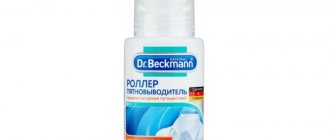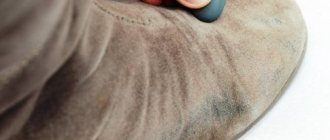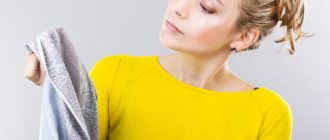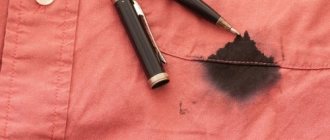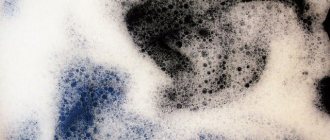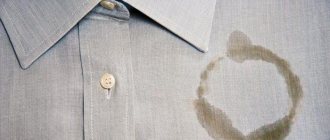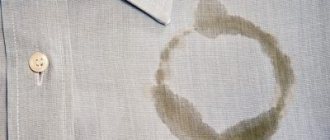How to remove sweat stains from white clothes?
Sweat marks are the fear of every woman, because they are especially visible on white clothes. The best way to get rid of sweat stains is to promptly wash your clothes using washing soap and leave them for several hours. But what to do if it was not possible to remove the stains in time?
Methods to help remove sweat from light-colored clothes
The first thing we must determine is the type of material from which the item is made.
A good stain remover is peroxide. Mix it with water and apply. “Fairy” copes well with sweat marks.
Aspirin is an excellent remedy for removing sweat stains, including yellow ones. It is necessary to dilute it with water and soak for a period of one to two hours. Then the items must be washed with running water.
You can try using toothpaste and cotton pads, as the paste contains antifreeze, which can help break down complex contaminants.
Tough stains
If untidy marks on clothes are discovered late, it will be much more difficult to wash them and you will have to put in more effort. Such contaminants are called difficult to remove. Sometimes you have to use strong bleaches to eliminate them, and in some cases only proven folk remedies help, because you don’t want to throw away your favorite things.
There are several types of stains that are very difficult to wash off. This category includes stains from:
- sweat;
- food;
- herbs;
- cosmetics;
- paints;
- blood.
Difficult to remove food stains can be divided into several categories. These are untidy blots from vegetables or fruits, drinks, fatty meat dishes. This also includes any derivative products:
- coffee;
- wine;
- sauce;
- jam;
- ketchup;
- jam;
- juice.
Food stains are easily removed at the very beginning. The more time passes from the moment they appear, the more difficult it will be to clean things up. Before choosing a method to eliminate the problem, you need to determine the type of fabric, the type of stain and the period during which the stains remained on the clothing. After studying the product label, it will be clear what types of processing are acceptable.
- Cialis Soft
- In Russia, a special procedure for service in stores will be introduced
- Why is it better for pensioners to refuse if they receive a call and are offered free medical care? examination
How to remove coffee from white clothes
How many things have you already thrown away that had coffee stains on them? It is this contamination that is considered one of the most serious, but if you know the tricks of dealing with it, you can easily save the thing.
Boiling and bleaching is the main method for removing coffee stains on white clothes. You can use boiling for natural fibers, and use bleach on white clothes.
By heating the water sufficiently to high temperatures - 90-110 degrees, you can effectively get rid of contamination. If chlorine bleach was used during bleaching, it is important to rinse the item as thoroughly as possible so that skin irritation does not occur afterwards.
Remove from things
Depending on the type of fabric from which the product is made, different cleaning agents are used. To remove yellow stains, carefully study the composition of the fabric on the label and the manufacturer’s recommendations.
For white cotton clothes, prepare a paste - a glass of water and four tablespoons of soda.
Rub it into the yellowish stains, leave it for an hour, and wash it in the washing machine. Attention! Do not rub too vigorously to avoid deformation of the fabric.
Heavily soiled cotton tablecloths and towels can be treated with a solution of ammonia and ethyl alcohol (1:1), then washed.
You can clean silk fabrics with a solution of salt and good powder. Soak the product in it for three hours, wash, rinse in water with the addition of three drops of brilliant green.
The question often arises: how can you clean white fur?
Cover the yellowed fur with a layer of crushed chalk, starch, flour or salt.
Using a brush, brush long fur in the direction of hair growth, and short fur against the direction of hair growth.
Beat the product thoroughly and vacuum it.
Problematic, greasy stains on white fur can be easily removed with a mixture of starch and gasoline.
The mixture is applied with a brush and left until completely dry, then the residue is thoroughly cleaned off, and the item is well ventilated.
Wash old ones from jackets, sweaters, dresses
You can wash off yellow stains from a white woolen sweater or jacket with laundry soap or a solution containing a glass of water, a small spoon of ammonia, and a tablespoon of glycerin. Soak the product for a couple of hours, rinse well, and dry.
Here are some proven ways to remove yellowness:
- Hydrogen peroxide. Soaking the product for several hours in warm water with peroxide in a ratio of 8:1 will help get rid of the yellowness that has appeared;
- Salt. It is recommended to use a saturated warm saline solution to bleach woolen products; repeat the procedure several times until visible dirt disappears;
- Chalk. Very effective for cleaning sheep's wool clothing, giving it dazzling whiteness. A sweater will require a kilogram of chalk. Dilute it thoroughly in a bowl of warm water, soak the item for an hour, stir the solution periodically to evenly distribute the chalk crystals;
- Store-bought oxygen-containing bleaches are effective in removing yellow stains from laundry.
This is interesting: If blood or urine gets on an orthopedic mattress, how to remove the stains
The following method will help remove yellowing from a wool hat:
- Wash the product with regular powder (do not use bleaches) in lukewarm water, no higher than 50°C (otherwise the wool will roll);
- Rinse in water with a small amount of boric acid added, squeeze;
- To add additional softness to the coat, add hair balm to the last rinse;
A universal product suitable for removing yellow stains from all types of fabrics:
- Hydrogen peroxide – 50 ml;
- Soda - a tablespoon;
- Dishwashing liquid – teaspoon.
Apply to problem areas, after two hours, rinse thoroughly and wash.
Remove from shirt, t-shirt, blouse
A concentrated solution containing water, salt and ammonia in a ratio of 1:1:4 will help remove the yellowness that appears on the collar, cuffs and armholes. Treat the yellow areas with the resulting mixture and wash off after two hours.
A solution of one ampoule of thiosulfate in a glass of water will help to wipe off a yellow stain on a blouse made of delicate fabric. This product will also add additional shine to a silk product.
Information. Use blue when rinsing white silk items after washing, it perfectly neutralizes yellowness.
There are several ways to remove yellow stains from things:
- Vegetable oil and bleach. Pour five liters of boiling water into a basin, add 70 grams of washing powder, two tablespoons of sunflower oil and bleach (not containing chlorine), if desired, you can add the same amount of any stain remover. Soak your clothes in this solution overnight, then wash them in the washing machine as usual;
- An old yellow stain from white things can be easily removed with the help of a thick paste consisting of equal parts of hydrogen peroxide and dishwashing liquid. Gradually add soda to this mixture until a paste-like mass is obtained. Apply the resulting slurry to the dirt, wait half an hour, rub thoroughly and wash with stain remover;
- Soaking in a concentrated soap solution with the addition of a teaspoon of vinegar will help remove yellowness from a shirt or T-shirt. If the old stains are isolated (for example, on the collar, cuffs or armhole of a shirt), additionally rub them with a paste containing water, soda and salt. After two hours, wash, then rinse well;
- Drugs from the pharmacy will also help remove unpleasant yellowness from things. Cover the old stain for three hours with a mixture prepared from two crushed aspirin tablets with water, scrub thoroughly, and rinse after washing;
- Dilute dry alcohol with water to a paste, treat stains, leave for several hours, wash;
- Hydrogen peroxide will help remove yellowed sweat stains from a T-shirt. After pre-soaking the items, pour peroxide onto the problem areas, wait until the foam stops hissing, and wash;
- If things are persistently soiled, you can bleach them by soaking them in warm water with the addition of alcohol and citric acid (a small spoon of alcohol and a pinch of acid per liter of water), then wash with a good quality powder;
Important! Sometimes, after washing with a low-quality powder, a yellow coating that is difficult to remove appears on white laundry. “Belizna” will cope well with it, but not a liquid product, but a powder in small bags.
How can you bleach fabric and linen?
What to do if the yellowness is already deeply ingrained into the product?
- Soak or treat the item with a solution of a small spoon of oxalic acid in a glass of water, wash;
- Moisten problem areas with vinegar, leave for fifteen minutes, then rub with laundry soap. After ten hours, wash;
- A glass of water with two tablespoons of citric acid will be cleaned in the same way as a solution of oxalic acid;
- A time-tested, reliable way to deal with any type of stain is to boil laundry, including children's laundry, for 15 minutes to two hours, depending on the degree of contamination. You can either boil it in a saturated solution of grated laundry soap, or use bleach.
This is interesting: How to remove a felt-tip pen from a rubber doll
Attention! Only cotton fabrics can be boiled; on other types, stains may appear even stronger after boiling.
Using all of the above means, you must follow some rules and recommendations so as not to spoil white things.
- Do not use chlorine-containing bleaches on white fabrics;
- Do not use too hot water, as it can make stains appear worse. It is better to wash traces of sweat in water no higher than 30°C;
- Silk should not be treated with vinegar and solvents, gasoline should not be used on synthetics, acids should not be used on cotton fabrics, and alkaline solutions (soda) should be used on woolen products.
Many of the products we are familiar with have whitening properties, but few people know how to use them.
Potassium permanganate.
In ten liters of warm water, stir three tablespoons of powder and potassium permanganate on the tip of a knife, wait until the crystals dissolve.
Soak the laundry in the resulting pinkish solution for about an hour, then rinse thoroughly.
This mixture will return the original whiteness to heavily washed items, and at the same time disinfect them: dilute five tablespoons of dry mustard in a liter of water, and when it has settled, pour it into a basin. Pour in four liters of water with diluted potassium permanganate (several crystals), let the items sit for an hour, and wash.
For bleaching silk and wool items, a solution of a tablespoon of mustard powder in a liter of water is suitable. Pour the settled mixture into a basin, add hot water, soak the items for half an hour, then wash as usual.
Important! When storing white items for long-term storage, place them in separate, breathable bags.
How to get rid of stains
The best option is to wash things as quickly as possible, before the coffee has time to completely saturate the fibers.
An excellent way to remove stains is to use laundry soap.
The maximum effect can be achieved with glycerin and ammonia. Dilute glycerin with water, add ammonia, and then apply to the stain.
If coffee has managed to saturate the fabric, it will be more difficult to deal with. For old stains, you can try the following:
- Laundry soap
- Glycerol
- Borax
- Ammonia
- Lemon juice
- Acetic acid
- Salt
- Soda
- Nail polish remover
- Peroxide.
These substances will help get rid of coffee stains on any material. Even if several weeks have passed since the contamination occurred.
Laundry soap
To remove stains, it is necessary to use laundry soap, because it contains fewer additives. To prepare a detergent, you need to grate the soap and pour boiling water over it. After cooling, apply. Rinse with water.
Glycerol
You can use slightly warmed glycerin to remove coffee stains. Wipe with a cotton pad soaked in glycerin. After this, leave the clothes for 30 minutes and let the glycerin act, wash with powder.
Glycerin in combination with salt copes well with old stains. The product is applied and left for 20 minutes.
Borax
It can not be found in every apartment. But if you are lucky enough to find it, it is an excellent stain remover. First, you need to go over the stain with a cotton pad, alcohol, and then brown. Be sure to wash your clothes with powder.
Ammonia
An excellent method for removing stains. It is necessary to heat 500 ml of water. Add 50 ml of ammonia and rub the laundry soap. Mix the resulting mixture well and cool.
After this, apply the product to areas of clothing. You may need to re-process.
Turpentine oil
Apply using a sponge. You can buy it at any pharmacy. Be as careful as possible with it, because it is a toxic substance.
Hydrogen peroxide
Peroxide is an excellent stain remover that can be found in every home. Please note that it may discolor the item, but for white outfits this does not matter. Its advantage is a gentle effect on the material, which cannot be said about the means we talked about earlier.
Lemon acid
First wipe with an ice cube. Pour in lemon juice and leave for a few minutes. After this, wash with powder.
Vinegar
Acetic acid can be added to the powder during washing. Add soda, acetic acid. The result should be a thick mixture. Apply and leave for 10 minutes.
Removing old grease stains
The question of how to remove old grease stains on white clothes is perhaps the most common, so we can’t help but give some valuable recipes against grease stains:
- Alcohol and turpentine. A very strong and aggressive product, which is why it is not suitable for use on delicate fabrics. Mix alcohol and turpentine in equal parts, stir thoroughly until smooth, then take a cotton pad and soak it in the prepared solution. Use this disc to wipe off all old greasy stains on white clothes, wait 2-3 hours and wash the clothes.
- Petrol. How to remove old stains from clothes if there is no turpentine? You can replace this potent component with gasoline, benzene, acetone or any other solvent. It must be mixed in equal proportions with water, and then soak all greasy stains. After the solution is absorbed, the clothes are washed with the powder.
- Ether and magnesia. Mix ether and magnesia and dilute with a small amount of water so that you end up with a thick paste. It must be placed on greasy stains and thoroughly rubbed into the fibers of the fabric using a brush (you can use a toothbrush). When the composition is absorbed (this takes from 30 to 90 minutes), the slurry is removed and the item is washed.
These are the most effective ways to remove old stains from clothes that have been stained with grease. Be careful with solvents - they burn quickly, so cleaning work with gasoline, benzene and others should be carried out away from fire.
Purchased and professional products
It doesn’t matter how long ago the stain was left, you can use special stain removers in any case. Bleach works well on coffee stains.
Bleaches
When choosing bleach, you must pay attention to:
- Preparations containing chlorine are only suitable for cotton and linen;
- Oxygen bleaches can be used on fabrics of any color.
Vanish Oxi Action is great for wool clothes.
When using bleach and other store-bought products, you need to carefully check whether they are suitable for cleaning upholstered furniture.
Stain removers – professional stain removal products
Selected depending on the type of fabric. Be sure to read what is written on the package. Most often it is necessary to apply and then wash using the usual method.
Table: overview of stain removers that can handle coffee stains
| Name | Purpose | Cost, r. |
| Vanish Gold Oxi Action | It must be mixed with water, then applied and washed using the usual method; Some buyers say that the product is less effective on old stains; Not suitable for silk products. | 500 |
| "Antipyatin" | The product is made on the basis of natural bile; It copes well with dirt, despite the fact that it is inexpensive; Can be used for all materials. | 70 |
| HG OXI | Can be used when soaking things with powder; Active oxygen is added during manufacturing; Eliminates unpleasant odors; Can be used for white and colored laundry. | 270 |
General rules for removing stains
Sometimes it is simply impossible to clean white and colored items. As a result, the dirt is firmly absorbed into the fibers and becomes more difficult to remove. Follow these guidelines throughout the cleaning process:
- Don't try to rub the stain even harder. Any movements should be as careful as possible and directed from the edge of the contamination to its center.
- Don't wet it right away. For example, grease and other oily traces from contact with water will only stick to the fabric.
- Be sure to test the fabric reaction. Before any cleaning, you need to apply a small amount of the selected product to an inconspicuous area of the item. Wait 5-10 minutes and watch the tissue reaction.
- Always follow the recommended proportions and holding time.
In order for any stain to disappear long ago without a trace or effort, it is necessary to let any product work. Then it will be much easier to remove dirt.
Thus, you can remove old stains on clothes even without resorting to strong chemicals. Aggressive chemicals can only be used on dense fabrics that are not capable of fading and can easily withstand such exposure. In other cases, it is better to immediately turn to professionals who will get rid of the problem with ease and without harm to things.
How to remove a grease stain on white clothes?
There are a large number of methods for removing grease stains and the choice of method depends on the type of material. First of all, it should be noted that it is easiest to deal with fresh contamination. Sprinkle in some salt as soon as the stain has been discovered. This will help reduce pollution. Then you can resort to professional preparators.
We suggest preparing a product with your own hands that will help get rid of dirt. There are two most proven methods of dealing with traces of grease - laundry soap and ammonia, turpentine.
Grate laundry soap. Dilute with water and heat, add ammonia. After this, apply to the problem area. Leave for a few minutes and rinse with running water.
If using salt the stain was reduced in size, we recommend using turpentine. Moisten the area around with cold water so that the mark does not increase in diameter. Moisten a sponge in turpentine and begin to scrub away the dirt little by little.
Why do yellow spots appear on white clothes after washing?
Items with new marks appearing are not what you expect to come out of the washing machine. The quality of washing depends on the powder and its dosage, the selected machine mode, and the water temperature. For white items, proper sorting of laundry is especially important.
Untidy stains and streaks on white fabric occur for several reasons:
- the fabric was soaked with sweat;
- interaction of an incorrectly selected antiperspirant with the body;
- cooking or cosmetic oils have come into contact with clothing - vegetable oil, foundation, sunscreen, body lotions;
- unsuitable detergent or too much detergent.
If, after washing, yellow spots are found on more than one item, most likely the problem is in low-quality washing powder. Most often this happens with sports, silk and woolen fabrics, for which ordinary powders or gels are not suitable. Things need to be rinsed without adding detergent, after which all stains will disappear.
Rust from the water “sticks” to greasy and sweaty areas during washing. Soiled items must be soaked before the main wash, sweat must be washed off with laundry soap, and greasy stains must be washed off with special products or powder enhancers.
Stubborn dirt
We offer several recipes for a quality stain remover. We also described how to effectively remove old and greasy stains in a detailed article about this problem.
List of actions that can be used to remove stains
- 1) Rub laundry soap. Fill with water and place on the stove.
- 2) Cool and then immerse clothes in water. Apply dissolved aspirin to the stain. Leave for two hours and then wash with powder.
Method of soaking things in acetic acid
Dilute acetic acid with water. Soak clothes in this mixture for 20 minutes. Apply ammonia to the stains. After this, rinse with citric acid. Leave for three hours and then wash with powder.
Sweat
For half a glass of water you will need 8 tablespoons of soda. The components are mixed, the resulting paste is applied to the contaminated areas and rubbed with a clothes brush. Then leave for an hour. After this, the item should be washed at a low water temperature. One treatment may not be enough, then the procedure is completely repeated.
To remove such stains, you can use aspirin. For one glass of warm water you will need 2 tablets. Contaminated white items are soaked in this solution for 3 hours, then put in the washing machine after rinsing.
Another option is hydrogen peroxide. Clothes are left to soak in an aqueous solution of the product for 30 minutes, then washed using powder in a washing machine.
Vinegar also helps remove sweat from white items. It is applied undiluted to the stain itself, left for half an hour, rinsed and washed.
For particularly strong or old traces of sweat, you can combine the two methods. First, the stained area is moistened with clean water, then baking soda is generously applied to it. Then pour in vinegar and leave the item to dry. After this, the remaining soda is simply shaken off, and the items themselves are washed in the machine.
Let's summarize
As you have already seen, it is quite possible to remove coffee stains. Even if it's an old trail. The main thing is to start fighting pollution as early as possible. There is no need to panic, much less throw away your clothes. With so many methods, you can definitely choose the right one for the situation that can restore the cleanliness of your clothes!
0 0 votes
Article rating

